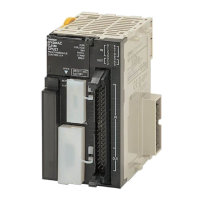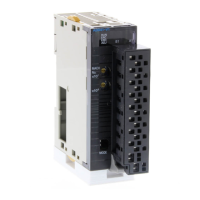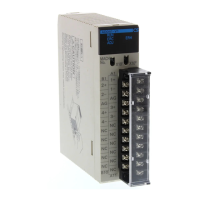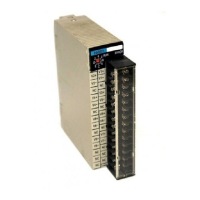182
Origin Search and Origin Return Functions Section 6-3
An origin search will not be started unless the origin search proximity speed is
less than the origin search high speed and unless the origin search/return ini-
tial speed is less than the origin search proximity speed.
6-3-3 Origin Search Error Processing
The CJ1M CPU Unit's pulse output function performs a basic error check
before starting to output pulses (when the instruction is executed) and will not
output pulses if the settings are incorrect. There are other errors that can
occur with the origin search function during pulse output, which may stop the
pulse output.
If an error occurs that stops pulse output, the pulse output's Output Stopped
Error Flag (A28007 or A28107) will be turned ON and the Pulse Output Stop
Error Code will be written to A444 or A445. Use these flags and error codes to
identify the cause of the error.
The Pulse Output Stop Errors will not affect the CPU Unit's operating status.
(The Pulse Output Stop Errors do not cause a fatal or non-fatal error in the
CPU Unit.)
Related Auxiliary Area Flags
Pulse Output Stop Error Codes
Word Bits Function Read/Write
A280 07 Pulse output 0 Pulse Output Stopped Error Flag
0: No error
1: Stop error occurred
Read only
A281 07 Pulse output 1 Pulse Output Stopped Error Flag
0: No error
1: Stop error occurred
Read only
A444 00 to 15 Pulse output 0 Pulse Output 0 Stop Error Code (See table below.) Read only
A445 00 to 15 Pulse output 1 Pulse Output 1 Stop Error Code (See table below.) Read only
Error name Error code Likely cause Corrective action Operation after
error
CW Limit Stop Input
Signal
0100 Stopped due to a CW limit signal
input.
Move in the CCW direction. Immediate stop,
No effect on
other port
CCW Limit Stop
Input Signal
0101 Stopped due to a CCW limit sig-
nal input.
Move in the CW direction.
No Origin Proximity
Input Signal
0200 The parameters indicate that the
Origin Proximity Input Signal is
being used, but a Origin Proxim-
ity Input Signal was not received
during the origin search.
Check the wiring of the Origin
Proximity Input Signal as well as
the PLC Setup's Origin Proxim-
ity Input Signal Type setting (NC
or NO) and execute the origin
search again. Turn the power
supply OFF and then ON if the
signal type setting was changed.
No effect on
other port
No Origin Input Sig-
nal
0201 The Origin Input Signal was not
received during the origin
search.
Check the wiring of the Origin
Input Signal as well as the PLC
Setup's Origin Input Signal Type
setting (NC or NO) and execute
the origin search again. Turn the
power supply OFF and then ON
if the signal type setting was
changed.

